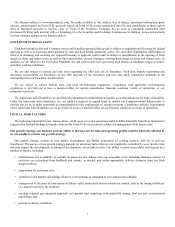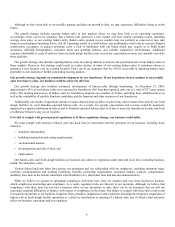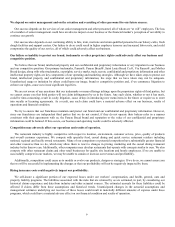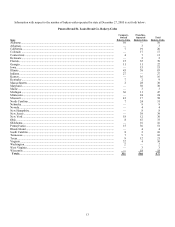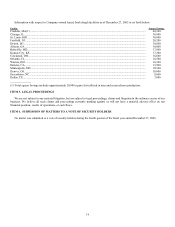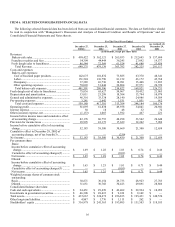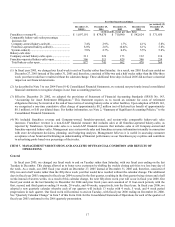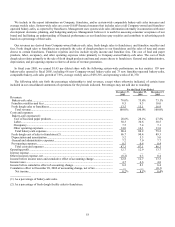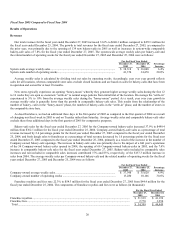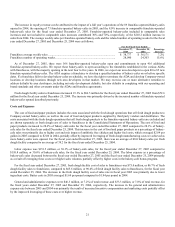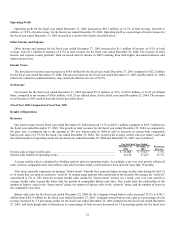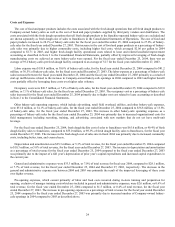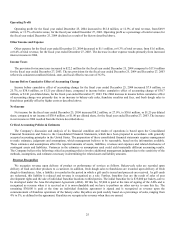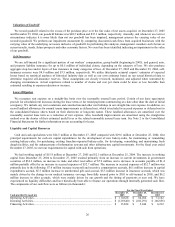Panera Bread 2005 Annual Report Download - page 23
Download and view the complete annual report
Please find page 23 of the 2005 Panera Bread annual report below. You can navigate through the pages in the report by either clicking on the pages listed below, or by using the keyword search tool below to find specific information within the annual report.
17
For The Fiscal Years Ended
December 27,
2005(1)
December 25,
2004
December 27,
2003
December 28,
2002
(as restated) (2)
December 29,
2001
(in thousands, except per share data)
Franchisee revenue(4)............................................... $ 1,097,191 $ 879,070 $ 710,980 $ 542,624 $ 371,650
Comparable bakery-cafe sales percentage
increases for:
Company-owned bakery-cafes(4) ........................... 7.4% 2.9% 1.7% 4.1% 5.8%
Franchise-operated bakery-cafes(4)........................ 8.0% 2.6% (0.4)% 6.1% 5.8%
System-wide(4) ....................................................... 7.8% 2.7% 0.2% 5.5% 5.8%
Bakery-cafe data:
Company-owned bakery-cafes open......................... 311 226 173 132 110
Franchise-operated bakery-cafes open...................... 566 515 429 346 259
Total bakery-cafes open.......................................... 877 741 602 478 369
____________
(1) In fiscal year 2005, we changed our fiscal week to end on Tuesday rather than Saturday. As a result, our 2005 fiscal year ended on
December 27, 2005 instead of December 31, 2005 and, therefore, consisted of fifty-two and a half weeks rather than the fifty-three
week year that would have resulted without the calendar change. These additional three days in fiscal 2005 did not have a material
impact on our financial statements.
(2) As described in Note 3 to our 2004 Form 10-K Consolidated Financial Statements, we restated our previously issued consolidated
financial statements to recognize changes in our lease accounting practices.
(3) Effective December 29, 2002, we adopted the provisions of Statement of Financial Accounting Standards (SFAS) No. 143,
“Accounting for Asset Retirement Obligations.” This Statement requires us to record an estimate for costs of retirement
obligations that may be incurred at the end of lease terms of existing bakery-cafes or other facilities. Upon adoption of SFAS 143,
we recognized a one-time cumulative effect charge of approximately $0.2 million (net of deferred tax benefit of approximately
$0.1 million), or $.01 per diluted share. For further information, see Note 2, “Summary of Significant Accounting Policies,” to the
Consolidated Financial Statements.
(4) We included franchisee revenue and Company-owned, franchise-operated, and system-wide comparable bakery-cafe sales
increases. Franchisee revenue is a non-GAAP financial measure that includes sales at all franchise-operated bakery-cafes, as
reported by franchisees. System-wide sales is a non-GAAP financial measure that includes sales at all Company-owned and
franchise-operated bakery-cafes. Management uses system-wide sales and franchisee revenue information internally in connection
with store development decisions, planning, and budgeting analyses. Management believes it is useful in assessing consumer
acceptance of our brand and facilitating an understanding of financial performance as our franchisees pay royalties and contribute
to advertising pools based on a percentage of their sales.
ITEM 7. MANAGEMENT’S DISCUSSION AND ANALYSIS OF FINANCIAL CONDITION AND RESULTS OF
OPERATIONS
General
In fiscal year 2005, we changed our fiscal week to end on Tuesday rather than Saturday, with our fiscal year ending on the last
Tuesday in December. This change allowed us to better serve customers by shifting the weekly closing activities to a less busy day of
the week. As a result, our 2005 fiscal year ended on December 27, 2005 instead of December 31, 2005 and, therefore, consisted of
fifty-two and a half weeks rather than the fifty-three week year that would have resulted without the calendar change. The additional
days in fiscal year 2005 compared to fiscal year 2004 occurred in the first quarter, resulting in the first quarter being sixteen and a half
weeks instead of sixteen weeks. As a result of this calendar change, the next fifty-three week year will occur in fiscal year 2008. Our
fiscal year ended on the last Saturday in December for 2004 and prior fiscal years and consisted of 13 four-week periods, with the
first, second, and third quarters ending 16 weeks, 28 weeks, and 40 weeks, respectively, into the fiscal year. In fiscal year 2006, we
adopted a new quarterly calendar whereby each of our quarters will include 13 weeks with 4 week, 5 week, and 4 week period
progressions in each quarter. Our fiscal week will continue to end on Tuesday, with fiscal year 2006 ending on December 26, 2006.
See “Quarterly Calendar Change” in Item 7 of this Form 10-K for the Consolidated Statement of Operations for each of the quarters of
fiscal year 2005 conformed to the 2006 quarterly presentation.


